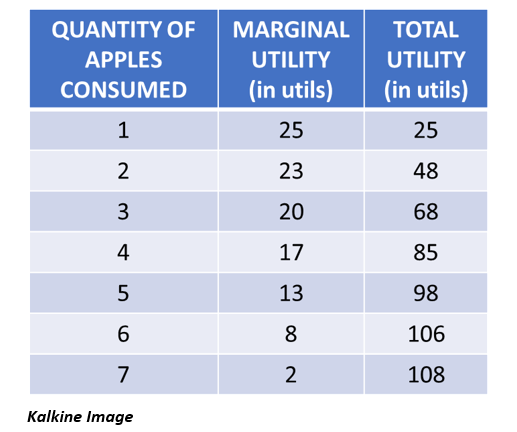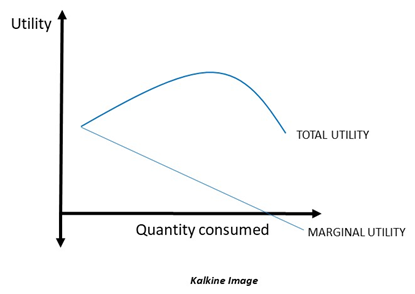What is Utility?
Utility is a term used in economics to represent the level of satisfaction derived from the consumption of a good. It can be thought of as a measure of satisfaction. It may or may not be quantifiable, depending on the type of utility.
Utility depends upon the wants of an individual. When the wants of an individual go unsatisfied, the utility decreases. Whereas, when the wants of an individual are satisfied, utility increases. Thus, human wants are the basis of utility. Had it not been for these unlimited wants of humans, the concept of utility would not have existed.
When a consumer derives higher utility from a good, he would demand more of that good. Therefore, utility drives the demand. He will keep on purchasing that good until he is satisfied. For example, a bar of chocolate is only of value to a consumer till it fetches him utility. He will keep consuming the chocolate till he is satisfied. This can happen when either his appetite reaches its limit, or when the chocolate stops being appealing to him.
How is Utility measured?
There are to ways to measure the utility:
- Ordinal Utility: Ordinal utility refers to the relative ranking of goods based on the utility they provide. It is not a quantitative method of measuring utility, rather it relies on the consumer’s ability to rank various goods based on the satisfaction derived from them. For example, if a consumer derives greater satisfaction from tea than from coffee, then he will rank tea higher than coffee in terms of utility.
- Cardinal Utility: This type of utility can be quantified and is more than just a measure of relative ranking. The unit used to measure the amount of utility is called a ‘util’. This is like any other unit of measurement like ‘grams’ for weight, ‘meters’ for length, and so on. Continuing from the above example, the consumer can quantify how much satisfaction tea provides over coffee. For instance, tea might fetch him 10 utils while coffee provides him 6 utils. Thus, it makes sense for him to consume more of tea.
What are some important aspects about Utility?
- Different from terms like usefulness, pleasure, satisfaction: Utility is an economic concept and its usage in economics differs from the English usage of the term. It might seem intuitive to equate utility with words like usefulness, pleasure, or satisfaction. However, these terms are not the same but are closely linked.
The usefulness of a commodity may not always ensure a higher utility derived from it. A good that is useful to a consumer might not satisfy his wants at a given time. Alternatively, a good with no amount of usefulness, like cigarettes, may provide immense utility to a smoker. Therefore, utility must not be confused with usefulness.
Similarly, pleasure and satisfaction are used in the definition of utility. However, these terms are not to be confused with the concept of utility.
- Utility is a psychological concept: This aspect makes utility even more difficult to measure. How individuals perceive utility is a debatable topic. The amount of satisfaction that one individual assigns to 1 ‘util’ can be different from the amount assigned by another individual. Thus, the mindset that goes behind assigning utility to a good is extremely subjective.
- No ethics attached to utility: Any item that may or may not be ethically correct can derive higher utility for an individual. Thus, utility solely depends on the wants of the consumer and is not based on any moral values.
- Utility is an individual concept: The concept of utility is highly subjective. There is no universal want that can justify the wants of all consumers. Every consumer has a different set of wants and attaches different levels of satisfaction to these wants. Thus, what may be true for one, might not be true for the other.
What are the types of Utility concepts?
Utility can be expressed as Total Utility and Marginal Utility. Both concepts are important concepts in economics and are used for deriving various other concepts in economics.
- Total utility: Total utility is the complete amount of satisfaction of wants received by an individual upon consuming the total quantity of a good. A consumer might attach different levels of utility to each individual unit of the same good. Total utility measures the complete satisfaction achieved upon consuming all units of the same good.
- Marginal utility: Marginal Utility measures the utility derived from each subsequent unit of the good consumed. This means that it is measured for only one unit of a good at a time, and not for the total quantity of goods consumed like in the case of total utility.
Consider the following example:
A consumer has 7 apples, each unit of apple has a different level of utility attached to it. This is the marginal utility. However, the total utility achieved on eating all the apples at a given time is a total utility. When the consumer has eaten 4 apples, going for the fifth apple would give him a marginal utility of only 13 utils.
At the same time, the total utility upon consuming the fifth apple would be the total utility derived up till the fourth apple plus the marginal utility of the fifth apple.

Marginal utility is negative when the consumption of the good causes harm to the consumer and does not give him satisfaction.
What is the Law of Diminishing Marginal Utility (DMU)?
The Law of diminishing marginal utility states that as an individual consumes more units of a good, the marginal utility of each subsequent good decreases. This means that no consumer would want to consume too much of the same good.
For instance, the first bar of chocolate would be highly satisfactory than the 10th bar of the same chocolate. Similarly, one scoop of ice cream would derive more utility for a consumer than the 15th scoop of the same ice cream.
Marginal utility and Total Utility can be represented through the following graphs:

 Please wait processing your request...
Please wait processing your request...